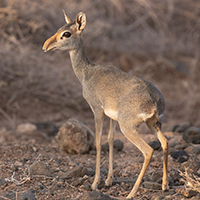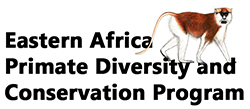
Northeast Kenya Antelope Survey
New Report
Tom Butynski and Yvonne de Jong
Report to Zoological Society for the Conservation of Species and Populations
This survey was kindly made possible by the inheritance of Michael Amend
March 2024
Summary:
Northeast Kenya is the most poorly known region in eastern Africa as concerns the taxonomy, distribution, abundance, threats, and conservation status of its larger mammals. Nonetheless, this region has a high number of threatened genera and species. Among the larger mammals, 15 species of antelope are known to occur. Diurnal surveys, nocturnal surveys, and camera trap surveys were conducted to cover as much of northeast Kenya (~130,000 km²) as possible in four fieldtrips (total of 48 days, total distance driven 7,163 km). The objectives of the Northeast Kenya Antelope Survey were to: (1) considerably improve our understanding of the taxonomic status, distribution, relative abundance, and threats to the region’s species of antelope; (2) contribute to the reassessments of their IUCN Red List degree of threat status; (3) provide practical, prioritized, recommendations for ameliorating the threats; and (4) bring local, national, and international attention to the unique biodiversity of northeast Kenya, using antelopes as a flagship group.

This survey was undertaken near the end of a 3–5-year drought. During this survey, antelope species were nowhere common outside of protected areas. Ten of the 15 antelope species of northeast Kenya were encountered. The species most frequently encountered was Kirk’s Dik-Dik Madoqua (kirkii) kirkii, followed by Southern Gerenuk Litocranius walleri walleri, and Bright’s Gazelle Nanger notata. The least common were Common Waterbuck Kobus ellipsiprymnus ellipsiprymnus and Greater Kudu Tragelaphus strepsiceros. The five species not encountered (Common Eland Tragelaphus oryx, Salt’s Dik-Dik Madoqua saltiana, Common Duiker Sylvicapra grimmia, Peter’s Gazelle Nanger petersii, Coke’s Hartebeest Alcelaphus buselaphus cokii) have geographic ranges that are on the margins of this region.

Beisa Oryx Oryx beisa beisa, Shaba National Reserve, central Kenya.
During this survey, we obtained range extensions for Kirk’s Dik-Dik (~130 km to the northeast) and Greater Kudu (~20 km to the east). The extension for Kirk’s Dik-Dik is particularly important as this increases the area of sympatry with Günther’s Dik-Dik Madoqua (guentheri) guentheri by ~18,000 km² to the north to the border with Ethiopia. This means that this species likely occurs in south Ethiopia. If so, this is a new large mammal for Ethiopia. Phenotypic descriptions and photographs obtained during this survey are not only instrumental for fine-tuning the east limit of Smith’s Dik-Dik Madoqua (guentheri) smithii and the west limit of Günther’s Dik-Dik, but also for detecting phenotypic clines and hybrid zones.

Adult female Southern Gerenuk Litocranius walleri walleri in commiphora woodland north of Habaswein, Kenya.
Beisa Oryx Oryx beisa were not detected outside the protected areas in the southwest corner of the study area. We suspect, however, that unprotected herds remain scattered over northeast Kenya. Bright’s Gazelle were most frequently encountered during the February–March 2023 survey when the drought was at its peak. It might be that this species was attracted to the edges of roads where some forage was present due to water run-off. Bright’s Gazelle were sometimes seen near people, villages, and large herds of livestock.
All antelope species in northeast Kenya are threatened to some extent by competition with livestock for food and/or water, habitat degradation, loss and fragmentation, as well as by poaching. Most of northeast Kenya is too arid for large-scale agriculture or even large-scale ranching. It appears that the antelope species most vulnerable in this region at this time are Beisa Oryx, Common Eland, and Greater Kudu. Common Impala Aepyceros melampus melampus, Common Waterbuck, and Coke’s Hartebeest have, historically, only occurred in northeast Kenya along the fringes of the Ewaso N’jiro River. This seems to still be the situation. Maasai Bushbuck Tragelaphus scriptus delamerei continues to be present on Mount Marsabit and along the Ewaso N’jiro River. Both species of Dik-Dik are relatively adaptable to human-caused habitat changes. To a certain extent, livestock grazing might favor them.
Most of northeast Kenya is, historically, unsuitable for the water-dependent species, including Common Impala, Maasai Bushbuck, Common Waterbuck, Common Eland, and Coke’s Hartebeest. We suspect that all of these species declined in abundance during the 3–5-year drought due to severe competition with livestock and, probably, intensified poaching. All of the water-independent antelope species known to, historically, occur in northeast Kenya are still present and widespread. With average to above average annual rainfall, these species are expected to recover well and to persist in this region long into the future. The data obtained during this survey can serve as a baseline for this expected recovery.

Adult male Bright’s Gazelle Nanger notata, Wayamdero Plain, west of Wajir, northeast Kenya.
Besides lagas (seasonally dry rivers), man-made perennial water sources (dams and boreholes) provide water to antelopes and other wildlife in some parts of northeast Kenya. Many man-made water sources are, however, unavailable to wildlife as they are fenced and/or occupied by people, livestock, and dogs. Although the vegetation in and around settlements is typically severely degraded by livestock, the human population in the region is relatively small and there are few roads. Therefore, large parts of northeast Kenya are little affected by people due to the scarcity of perennial sources of water.

Adult female Somali Lesser Galago Galago gallarum, Marsabit, north Kenya.
Thirty-one mammal species, other than antelopes, were encountered during this survey, six of which are ‘threatened’ (Vulnerable, Endangered, Critically Endangered). We obtained altitudinal range extensions and/or geographic range extensions, and natural history data for Desert (Somali) Warthog Phacochoerus aethiopicus delamerei, Common Warthog Phacochoerus africanus, Somali Lesser Galago Galago gallarum, Olive Baboon Papio anubis, Pancake (Crevice) Tortoise Malacochersus tornieri, and several bird species, including Short-Toed Snake Eagle Circaetus gallicus.
All 10 antelope species distribution maps presented in this report, and some non-antelope species maps, will be further updated based on (1) geographic range extensions found during this survey, (2) application of soil and vegetation shapefiles that help identify areas of unsuitable habitat, and (3) our database which includes locality records compiled over the past 23 years.

Lanner Falcon Falco biarmicus, Sera Conservancy, central Kenya
Trackback from your site.

